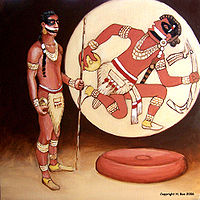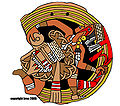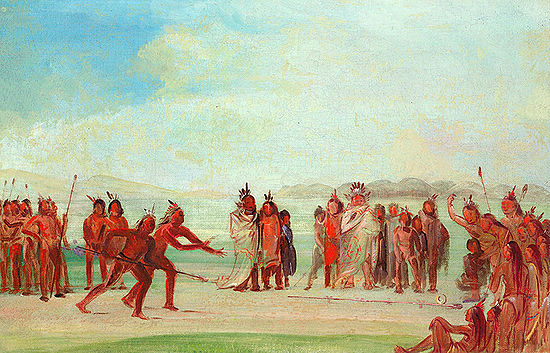
Chunkey
Encyclopedia

Game
A game is structured playing, usually undertaken for enjoyment and sometimes used as an educational tool. Games are distinct from work, which is usually carried out for remuneration, and from art, which is more often an expression of aesthetic or ideological elements...
of Native American
Native Americans in the United States
Native Americans in the United States are the indigenous peoples in North America within the boundaries of the present-day continental United States, parts of Alaska, and the island state of Hawaii. They are composed of numerous, distinct tribes, states, and ethnic groups, many of which survive as...
origin. It was played by rolling disc shaped stones across the ground and throwing spears at them in an attempt to place the spear as close to the stopped stone as possible. It originated around 600 CE in the Cahokia
Cahokia
Cahokia Mounds State Historic Site is the area of an ancient indigenous city located in the American Bottom floodplain, between East Saint Louis and Collinsville in south-western Illinois, across the Mississippi River from St. Louis, Missouri. The site included 120 human-built earthwork mounds...
region of what is now the United States
United States
The United States of America is a federal constitutional republic comprising fifty states and a federal district...
(near modern St. Louis
St. Louis, Missouri
St. Louis is an independent city on the eastern border of Missouri, United States. With a population of 319,294, it was the 58th-largest U.S. city at the 2010 U.S. Census. The Greater St...
, Missouri
Missouri
Missouri is a US state located in the Midwestern United States, bordered by Iowa, Illinois, Kentucky, Tennessee, Arkansas, Oklahoma, Kansas and Nebraska. With a 2010 population of 5,988,927, Missouri is the 18th most populous state in the nation and the fifth most populous in the Midwest. It...
). Chunkey was played in huge arenas as large as 19 hectares that housed great audiences designed to bring people of the region together (i.e. Cahokians, farmers, immigrants, and even visitors). It continued to be played after the fall of the Mississippian culture
Mississippian culture
The Mississippian culture was a mound-building Native American culture that flourished in what is now the Midwestern, Eastern, and Southeastern United States from approximately 800 CE to 1500 CE, varying regionally....
around 1500 CE. Variations were played throughout North America
North America
North America is a continent wholly within the Northern Hemisphere and almost wholly within the Western Hemisphere. It is also considered a northern subcontinent of the Americas...
. Early ethnographer James Adair
James Adair (historian)
James Adair was a native of County Antrim, Ireland, who came to North America, and became a trader with the Native Americans of the southern states...
translated the name to mean "running hard labor". Gambling
Gambling
Gambling is the wagering of money or something of material value on an event with an uncertain outcome with the primary intent of winning additional money and/or material goods...
was frequently connected with the game, with some players wagering everything they owned on the outcome of the game. Losers were even known to commit suicide.
Graphic representation

Southeastern Ceremonial Complex
The Southeastern Ceremonial Complex is the name given to the regional stylistic similarity of artifacts, iconography, ceremonies, and mythology of the Mississippian culture that coincided with their adoption of maize agriculture and chiefdom-level complex social organization from...
. Many different representations of the theme have been found all over the American Southeast and Midwest. Throughout the many different centuries of its portrayal, certain distinct motifs are repeated:
- stance- Many graphic representations of the chunkey player show the participant in the act of tossing the stone roller.
- broken stick- The chunkey stick is usually shown as a stripped stick, almost always broken. In the mythological cycle, this may signify that the game is over, if not defeat itself. Chunkey sticks are usually not found in archaeological excavations, although a copper sheath found next to chunkey stones at Cahokias Mound 72 may be an exception.
- pillbox hat- A cylindral shaped hat composed of unknown materials, only seen on chunkey players.
- heart/bellows shaped apron- Archaeologists theorize that this may be the graphic representation of a human scalp attached to the belt of the figure. This motif seems to echo the beaded forelock, hair style (head shaved except for top-knot) and other attachments (shell, stone and copper ornaments) usually worn by mythological figures on their heads.
- Mangum Flounce- An oddly shaped motif consisting of looping lines hanging above and below the belt of the chunkey player.
Although the figure described as the falcon dancer/warrior/chunkey player is not always shown in the act of playing chunkey, the placing of many of the motifs helps identify them as the same figure. Some motifs usually associated with the figure, such as the scalp, severed heads, broken chunkey sticks, and the ethnohistoric record associating it with gambling, seem to indicate the seriousness of the game. The price of defeat in the mythological record may have been the forfeiture of ones life and head.
Post European contact

Chickasaw
The Chickasaw are Native American people originally from the region that would become the Southeastern United States...
, Chumash , Choctaw
Choctaw
The Choctaw are a Native American people originally from the Southeastern United States...
, and the Mandans, as witnessed by the artist George Catlin
George Catlin
George Catlin was an American painter, author and traveler who specialized in portraits of Native Americans in the Old West.-Early years:...
in 1832 -
In the early colonial era, it was still the most popular game among American Indians of the Southeast. Creek chunkey yards were a large carefully cleared and leveled area, surrounded by embankments on either side, with a pole in the center, and possibly 2 more at either end. The poles were used for playing another indigenous game, the ball game
History of Lacrosse
Lacrosse has its origins in a tribal game played by all eastern Woodlands Native Americans and by some Plains Indians tribes in what is now Canada. The game has been modernized extensively by European immigrants to create its current form....
. The stones, valuable objects in themselves, were owned by the town or clans, not by individuals, and would be carefully preserved.
- CherokeeCherokeeThe Cherokee are a Native American people historically settled in the Southeastern United States . Linguistically, they are part of the Iroquoian language family...
s scored their game in terms of how close the stone was to certain marks on the chunkey stick. - ChickasawChickasawThe Chickasaw are Native American people originally from the region that would become the Southeastern United States...
s scored their game with a point for the person nearest the disc, two if it was touching the disc. - ChoctawChoctawThe Choctaw are a Native American people originally from the Southeastern United States...
s played their game on a yard 12 feet (3.7 m) wide by 100 feet (30.5 m) in length. Poles were made of hickoryHickoryTrees in the genus Carya are commonly known as hickory, derived from the Powhatan language of Virginia. The genus includes 17–19 species of deciduous trees with pinnately compound leaves and big nuts...
wood, with four notches on the front end, one in the middle, and two at the other end. The score depended on which set of notches was closest to the disc. The game ended when a player had reached twelve points.

